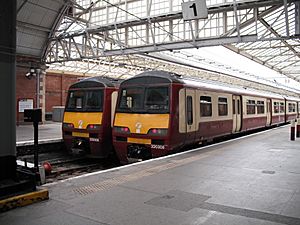British Rail Class 320 facts for kids
Quick facts for kids British Rail Class 320 |
|
|---|---|

Class 320 Units 320306 and 320308 at Helensburgh Central railway station
|
|
| In service | 1990 - Current |
| Manufacturer | BREL York |
| Number built | 22 trainsets |
| Formation | 3 cars per trainset |
| Operator(s) | First ScotRail |
| Specifications | |
| Maximum speed | 75mph (121 km/h) |
| Weight | Total -114.5 tonnes |
| Braking system(s) | Air (Westcode) |
| Track gauge | Standard gauge: 1,435 mm (4 ft 8½ in) |

The British Rail Class 320 is a special type of alternating current (AC) electric multiple unit (EMU) train. This means it's a train that can run by itself using electricity, without needing a separate engine. These trains are used for passenger services in Central Scotland. They are known for their distinctive look and their role in connecting towns and cities on the Strathclyde Partnership for Transport (SPT) rail network.
Contents
What is the British Rail Class 320?
The Class 320 trains were built by BREL (British Rail Engineering Limited) in York. They started running in 1990. Each Class 320 train is made up of three connected cars. These trains are designed to run on electricity, specifically using alternating current (AC) power.
Where do these trains run?
Class 320 trains are mainly used in Central Scotland. They operate on the North Clyde Line. This line connects towns like Helensburgh and Airdrie, North Lanarkshire. The trains also pass through Glasgow Queen Street railway station. They are an important part of the local transport system.
How fast can they go?
When they were first built, the Class 320 trains could travel at a top speed of 75 miles per hour (121 km/h). This speed was good for the routes they served. Later, some of these trains were upgraded to go even faster.
What happened to the Class 320 trains?
Around 2010, there were some big changes for the Class 320 trains. Other new trains, like the Class 380s, were being introduced. This meant the Class 320s would be used on different routes.
Upgrades and new routes
Many Class 320 trains were moved to work on the Cathcart Circle lines. Others continued to work alongside Class 318 trains on the North Clyde and Argyll lines. To do this, the trains needed important upgrades.
The trains were sent to a company called WABTEC in Doncaster. There, they got a full refurbishment. This included new seats and new toilets. They were also painted in the new ScotRail "Saltire" livery, which is a special paint scheme. Their top speed was also increased to 90 miles per hour (145 km/h). These upgrades made the trains more modern and comfortable for passengers.
Images for kids
-
Unrefurbished 320s at Helensburgh Central
See also
 In Spanish: Clase 320 de los Ferrocarriles Británicos para niños
In Spanish: Clase 320 de los Ferrocarriles Británicos para niños



